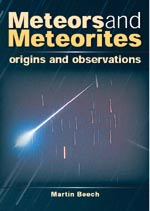 In previous blogs, I’ve written about my love for meteorites, including my trip to the Center for Meteorite Studies at Arizona State University. I also have a small but enjoyable meteorite collection. As an observational astronomer, I enjoy viewng meteor showers. A recently published book combines these interests and adds a lot more.
In previous blogs, I’ve written about my love for meteorites, including my trip to the Center for Meteorite Studies at Arizona State University. I also have a small but enjoyable meteorite collection. As an observational astronomer, I enjoy viewng meteor showers. A recently published book combines these interests and adds a lot more.
Meteors and Meteorites: Origins and Observations by Martin Beech (The Crowood Press, 2006) begins in space with Chapter 1, “The Particulate Sea.” Beech’s writing style is engaging and informative. In this chapter, he lays the groundwork for an amateur astronomer to understand the processes that create meteors, and may lead to meteorites.
Chapter 2, “The View from Here,” explains why we see meteors and shows the geometry of meteor showers. I found the section, “The Sporadic Background,” particularly interesting. Although the oft-quoted average of 7 sporadic meteors per hour holds true overall, Northern Hemisphere observers will see a peak of 10 sporadics per hour around the September equinox. A minimum of 4 sporadics per hour occurs near the March equinox. In the Southern Hemisphere, these numbers reverse.
In later chapters, Beech covers topics including collecting meteorites and radio observation of meteors. Throughout the book, you’ll find numerous charts, graphs, tables, and carefully selected black and white photos. In the Appendix, the author describes eight major meteor showers and includes star charts showing each event’s radiant.
Beech does all this in a scant 157 pages. I’ll be recommending Meteors and Meteorites: Origins and Observations to observers who want a quick but thorough read explaining the ins and outs of meteors, meteor showers, and meteorites.